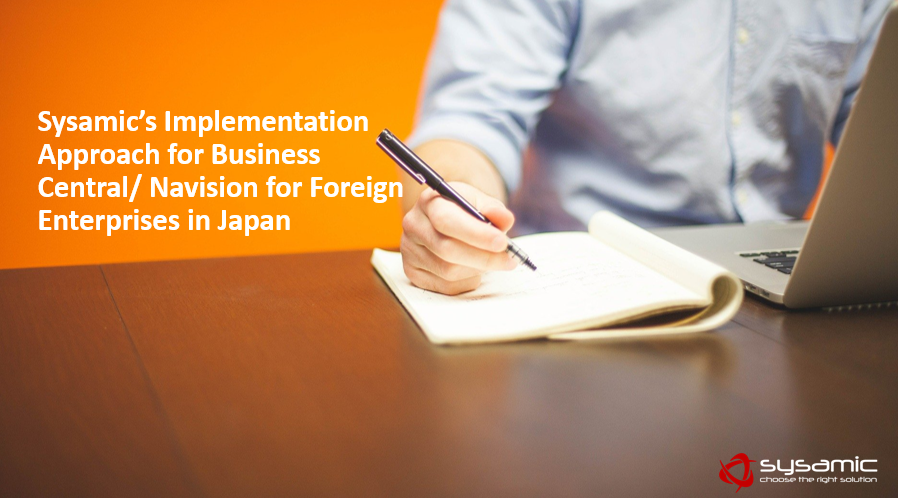When a North American company in Japan wants to deploy an ERP or a CRM system, it is typically driven from the company’s headquarters. From system selection to implementation, the headquarters’ IT department is heavily involved in the project. A partner who worked on a headquarters-based IT project is occasionally invited to come to a local office for project support and coordination.
In Japan, U.S and European companies require additional help in financial consolidation, compliance, and inventory management consulting. It is imperative to standardize features including accounting chart of accounts (COA) and localization structure, item masters, dimensions, inventory valuations, the integration of charges for item cost, security, and internal control to fulfil the corporate requirements.

Sysamic’s Approach and Methodology of Implementation
1. Business Requirements Documentation
Let us consider the corporate office in Japan has decided to adopt Dynamics 365 Business Central/Navision and has already prepared a corporate template however the template needs to apply local workflows, financial structure and methodologies.
2. Authorized by Headquarters
For overseas subsidiaries, the headquarters strongly suggests Dynamics ERP – Navision (NAV) or Business Central as the standard ERP software.
3. Next Action plan by Affiliate in Japan
Affiliate or IT consulting or partner companies in Japan like Sysamic proceed ahead with the selection and implementation of the system.
Corporate office in Japan has decided to adopt Dynamics 365 Business Central/Navision and has already prepared a corporate template.
In this situation, the headquarters has already created a corporate template (database) for global use. Because the headquarters IT team will not be able to get a sufficient understanding of Japanese business practices and taxation requirements, the system template built at the headquarters will be impossible to adapt to the Japanese business environment without modification. To fulfil local needs, the template must be translated as well as specialized functions such as Collective Invoices, Firm Banking, Promissory Notes, Sales Tax, Distribution Management, and corresponding report output must be developed. To begin the project, you must first gain a thorough understanding of the corporate template produced by the headquarters. This necessitates a “Knowledge Transfer” session with the headquarters’ IT employees, the Microsoft Dynamics partner who assisted with development, and the local Microsoft Dynamics partner like Sysamic assigned to global project support. Next, Sysamic builds up the system according to Japanese regulations after evaluating the template.
For overseas subsidiaries, the headquarters strongly suggests Dynamics ERP – Navision (NAV) or Business Central as the standard ERP software.
To begin, it is critical to have a thorough understanding of the company’s requirements. Following the validation of corporate demands, local system development should be carried out following global principles. If the corporate requirements do not exist or are not clear enough, it may be necessary to work together with the headquarters’ IT department to resolve the issue.
Compared to the previous approach, this allows for a more flexible and user-friendly system to be designed based on the needs of the local office, if the essential corporate requirements are met. Nonetheless, it is critical to maintain strong communication between the headquarters and the local Japanese organization by sending the proper project status reports to the headquarters. In the selection and implementation of the system, the affiliate in Japan (in this case, Sysamic) takes the lead.
Affiliate in Japan proceeds ahead with the Selection and Implementation of the system
This pattern, out of the three, offers the most flexibility in terms of execution. The company in Japan, on the other hand, must first choose an ERP system and an experienced Microsoft ERP Implementation partner. There are various considerations to be made at this time, as mentioned below:
- Choosing a globally recognized, dependable ERP solution, in this case, Dynamics 365 Business Central/Navision or CEGID or something else.
- Choosing an ERP solution that supports multi-language and multi-currency transactions, as well as IFRS compliance. All Microsoft ERPs including Business Central/Navision satisfy these criteria and are fully compliant.
- The presence of bilingual consultants at the local partner ensures that the required level of contact with the headquarters is maintained. Sysamic, Japan-based IT Consulting partner, with over 20 years of experience is the champion in this method.
Many North American and European companies in Japan request that their IT infrastructure and relevant support be created at the same time as their Business Central/Navision deployment. As a result, validating the IT infrastructure specifications with the headquarters is a critical step. Also, simultaneously, establishing and sustaining effective communication between local offices and headquarters is important to successful system adoption in each strategy and who knows better than Syamic who has spent 20 years in this space!
About Sysamic:
Sysamic is a modern business consulting company focused on technology, design, and business transformation. In Japan, we have over 20 years of experience supporting businesses to enter the market and accelerate growth. Our core services include eCommerce consulting and development, Business solution consulting, IT Consulting, CEGID Y2 Retail, Microsoft Dynamics 365 Business Central and Navision (NAV) ERP Analysis and Implementation, and Infrastructure support.
At Sysamic, we value our biggest assets – our employees! Join our Dynamics 365 team now!
